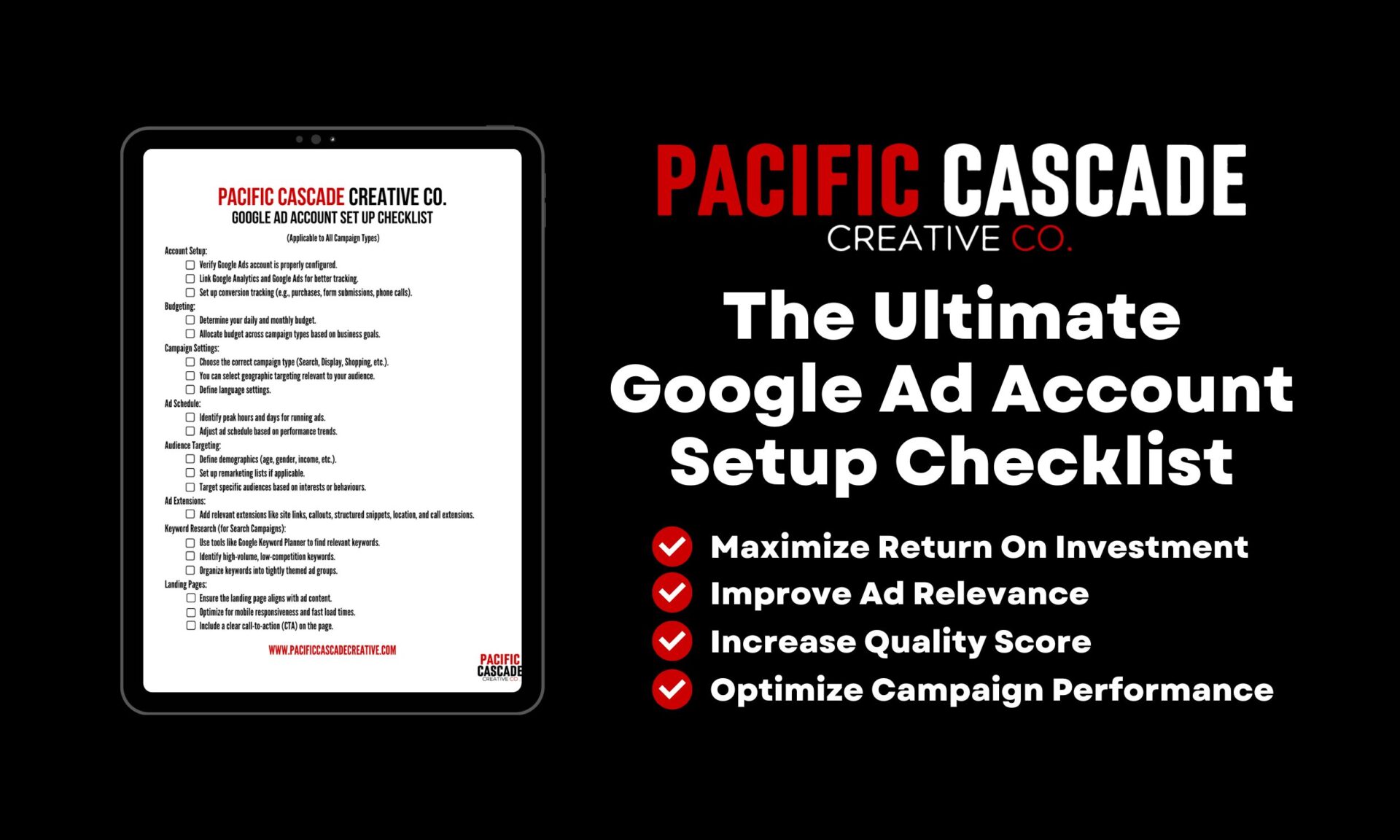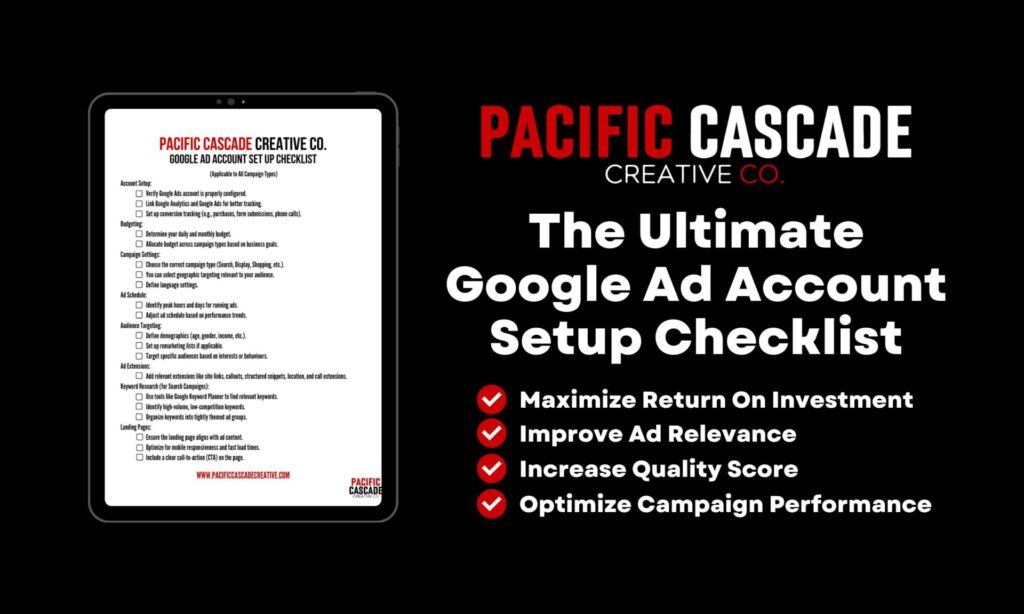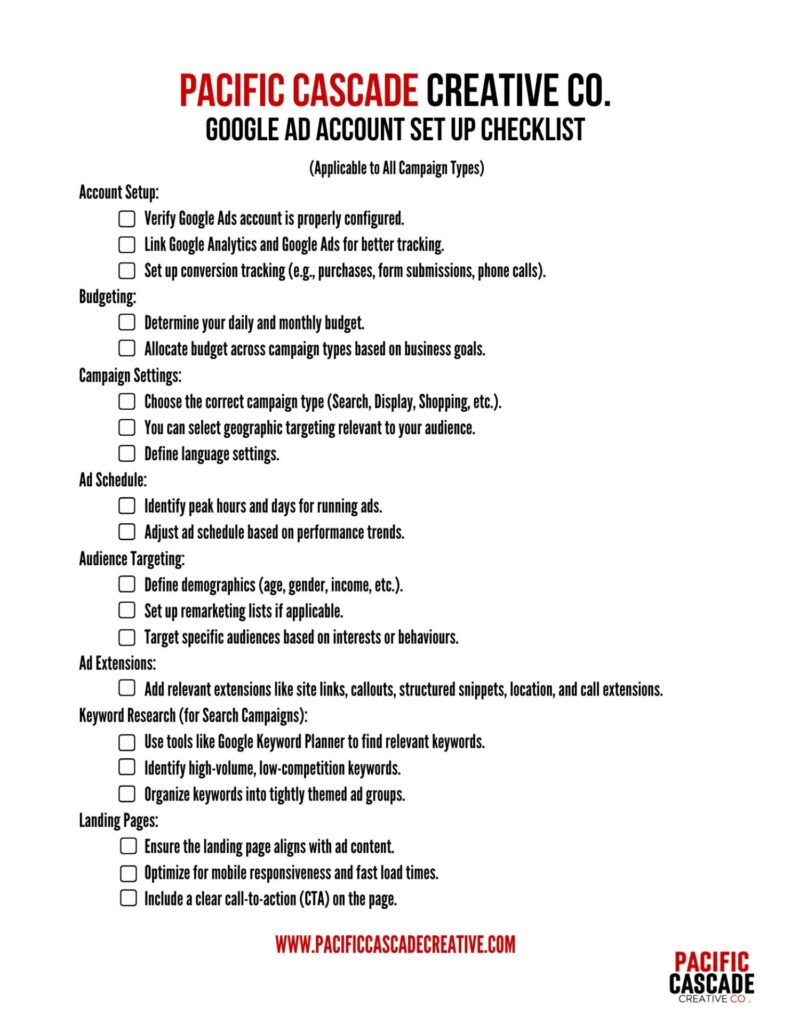

Free Google Ad Account Setup Checklist
Google Ad Account Setup is FREE and is one of the smartest moves a business can make to skyrocket online visibility and drive targeted traffic to your website. With Google Ads, you can reach potential customers at the exact moment they’re searching for your products or services, ensuring your ad dollars are spent effectively. The platform offers robust targeting options, allowing you to narrow your audience by location, demographics, interests, and even specific keywords.
Additionally, Google Ad’s measurable results mean you can track every click, impression, and conversion, making it easy to refine your campaigns for maximum ROI. Whether you’re a small business looking to build brand awareness or an established company aiming to scale, Google Ads provides the tools to grow your business quickly and efficiently. That why Pacific Cascade Creative has created you a FREE actionable, step-by-step checklist for Google Ad Account Setup optimization.
GET YOUR FREE GOOGLE AD ACCOUNT SETUP CHECKLIST NOW!
Why Does Strategic Google Ad Account Setup Matter?
A strategic Google Ad Account Setup is essential for maximizing ROI, improving ad performance, and aligning campaigns with business goals. By organizing campaigns, ad groups, and keywords effectively, you can boost Quality Scores, reduce costs per click, and target the right audience with precision. A well-structured account simplifies optimization, enhances data analysis, and prevents ads from competing against each other, saving time and money.
An effective Google Ad Account Setup also supports better customer targeting through geo-targeting, audience segmentation, and ad scheduling, while enabling effective A/B testing for continuous improvement. Ultimately, a thoughtful account structure ensures scalability, allowing businesses to grow their campaigns efficiently and achieve long-term success. Here’s why it matters:
1. Maximizes Return On Investment
A well-organized account ensures that your budget is allocated effectively, targeting the right audience with the right message. Poor structure can lead to wasted spend on irrelevant clicks.
Here’s how Google Ad account Setup is done correctly can help you achieve higher ROI:
Set Clear Goals and Conversion Tracking
Before diving into Google Ads, it’s crucial to define what success looks like for your business. Whether it’s generating leads, driving online sales, or increasing website traffic, setting clear objectives will guide your campaign setup.
- Conversion Tracking: Implement Google Ads Conversion Tracking to monitor actions like form submissions, purchases, or phone calls. By tracking conversions, you can evaluate which ads, keywords, and campaigns are driving the most valuable results, allowing you to optimize for higher ROI.
- Google Analytics Integration: Link your Google Ads account to Google Analytics to get a more comprehensive view of user behavior on your site. This helps refine your strategy based on both on-site actions and conversion outcomes.
Target the Right Audience
Proper audience targeting ensures that you’re spending your budget on users who are more likely to convert, which directly boosts ROI.
- Keyword Research: Conduct thorough keyword research using tools like Google Keyword Planner to find keywords with high intent and relevance to your business. Focus on long-tail keywords with lower competition but high conversion potential.
- Audience Targeting: Utilize audience targeting features in Google Ads, such as:
- In-market audiences: Target users actively searching for products or services similar to what you offer.
- Remarketing: Re-engage previous website visitors who have shown interest but have not converted, improving the likelihood of conversion.
- Demographic targeting: Tailor your ads to specific age groups, genders, household incomes, and locations that are most likely to drive ROI.
- Geographic Targeting: Limit your ads to specific locations where your ideal customers are located. This prevents wasted spend on users outside your target market.
Optimize Ad Copy and Landing Pages
Your ads and landing pages should be tailored to match the needs of your target audience and encourage conversions.
- Compelling Ad Copy: Write clear, concise, and compelling ad copy that addresses your audience’s pain points and provides a strong call to action. Highlight your unique selling points (USPs) and ensure that your ad copy aligns with the keywords you’re targeting.
- A/B Testing: Test different variations of ad copy to determine which version resonates best with your audience. Continuously test your headlines, descriptions, and calls to action to improve ad performance.
- Optimized Landing Pages: Ensure that your landing pages match the ad’s messaging and offer a seamless user experience. Fast-loading, mobile-friendly, and relevant landing pages help increase conversion rates and reduce bounce rates.
Choose the Right Bidding Strategy
Google Ads offers several bidding strategies, and selecting the right one is key to maximizing ROI.
- Manual CPC: Gives you control over your bids, allowing you to adjust them based on the performance of specific keywords or ads.
- Enhanced CPC: Automatically adjusts your manual bids based on the likelihood of a conversion, helping you get more conversions without requiring constant monitoring.
- Target CPA (Cost Per Acquisition): If your goal is to drive conversions at a specific cost, this bidding strategy focuses on maximizing conversions while staying within your target CPA.
- Maximize Conversions: This strategy uses machine learning to optimize your bids and help you get the most conversions for your budget, making it ideal if you’re focused on increasing conversions rather than specific costs.
- Target ROAS (Return on Ad Spend): If you have a specific return goal, this bidding strategy focuses on maximizing the return on ad spend (ROAS) based on your historical data.
Optimize Your Budget Allocation
Efficiently managing your budget ensures that you’re allocating your funds where they’ll have the most impact, helping to maximize ROI.
- Budget Distribution: Set your daily budget based on campaign goals and performance. Allocate more budget to campaigns that are performing well and adjust accordingly if certain campaigns are underperforming.
- Bid Adjustments: Use bid adjustments to prioritize ads that perform well. For instance, you can increase bids for mobile users if they convert better on your site or increase bids during certain times of the day when conversions are more likely.
Use Ad Extensions
Ad extensions provide additional information in your ads and increase their visibility on the search results page. This can improve your click-through rate (CTR), leading to higher ROI.
- Sitelink Extensions: Direct users to specific pages on your website, increasing the likelihood of engagement.
- Call Extensions: Make it easy for users to contact you directly, which is especially useful for businesses that rely on phone calls.
- Location Extensions: Show your business address and encourage users to visit your physical location.
- Price Extensions: Display your product or service prices directly in the ad to attract users looking for cost information.
Monitor Performance and Adjust
Regular monitoring and optimization are essential for maximizing ROI in Google Ads.
- Analyze Campaign Performance: Use the Google Ads Dashboard to track key metrics like CTR, conversion rate, cost per conversion, and ROAS. Evaluate how well your campaigns align with your goals.
- Adjust Targeting: Refine your audience targeting, keywords, and ad copy based on performance data. Pause underperforming keywords and ads, and allocate more budget to high-converting ones.
- Optimize for Quality Score: Google’s Quality Score is based on the relevance of your ads, keywords, and landing pages. Improving your Quality Score can lower your cost per click (CPC), leading to a higher ROI. Ensure that your ads are highly relevant and that your landing pages provide a great user experience.
Leverage Automated Rules and Scripts
Google Ads offers automation tools to help optimize your campaigns more efficiently.
- Automated Rules: Set up automated rules to adjust bids, budgets, and ad statuses based on performance. For example, you can increase bids for high-converting keywords or pause underperforming campaigns automatically.
- Google Ads Scripts: Use custom scripts to automate more advanced tasks, such as pausing ads with low ROAS or adjusting bids based on weather data or stock levels.
Regularly Review and Optimize Campaigns
Google Ads is an ongoing process that requires regular adjustments and testing to ensure the highest ROI.
- Seasonal Adjustments: Adapt your campaigns for seasonal trends, product launches, or special promotions.
- Keyword Refinement: Continuously evaluate keyword performance and refine your targeting. Negative keywords can help filter out irrelevant traffic, ensuring your budget is used more efficiently.
- Ad Testing: Regularly test new ad copy and creatives to identify what works best and optimize for performance.
By using a strategic Google Ad Account Setup with a well-thought-out strategy and consistently optimizing based on performance data, you can maximize your return on investment. This approach ensures that your ad spend is allocated effectively, targeting the right audience, and driving the results that matter most to your business.
2. Improves Ad Relevance and Quality Score
A proper Google Ad Account Setup significantly improves ad relevance and Quality Score, which are critical factors in achieving better performance and lower costs. Ad relevance measures how closely your ad matches the intent behind a user’s search query. A well-structured account ensures that your campaigns are organized into tightly themed ad groups, each containing specific keywords that align directly with your ads and landing pages. This alignment makes it more likely that your ads address the user’s needs, improving their relevance and encouraging higher engagement rates.
Quality Score, determined by factors like expected click-through rate (CTR), ad relevance, and landing page experience, benefits greatly from a properly set up account. By selecting the right keywords through thorough research, writing compelling and targeted ad copy, and linking to optimized landing pages, you create a seamless user experience. High relevance and CTR signal to Google that your ads are useful, which can lead to a higher Quality Score. In turn, this reduces your cost-per-click (CPC) and increases your ad placement in search results, ultimately maximizing your return on investment.
3. Enhances Campaign Performance
Optimizing Google Ad Account Setup enhances campaign performance by ensuring that your ads are targeted, relevant, and optimized for user engagement. When your account is organized with clear goals, well-structured campaigns, and precise audience targeting, it ensures that your ads reach the right people at the right time. This reduces wasted ad spend on irrelevant clicks and increases the likelihood of driving valuable actions, such as purchases, leads, or sign-ups.
Additionally, improved ad relevance—achieved through carefully selected keywords, compelling ad copy, and optimized landing pages—boosts your Quality Score, which is a key determinant of your campaign’s cost and placement. A higher Quality Score means you can achieve better ad positions while paying less per click, allowing you to make the most of your advertising budget. Moreover, features like conversion tracking and A/B testing help fine-tune performance by identifying what works best, enabling you to continuously optimize for higher click-through rates (CTR) and conversion rates. Ultimately, a Google Ad Account Setup that is well done leads to more efficient spending, increased engagement, and better overall results.
4. Simplifies Optimization
Google Ad Account Setup done right simplifies optimization by providing a clear, organized framework for monitoring performance and making adjustments. When your campaigns are structured with specific goals, tightly themed ad groups, and targeted keywords, it becomes easier to pinpoint which elements are working and which need improvement. For example, with well-organized ad groups, you can quickly identify underperforming keywords or ads without sifting through unrelated data, allowing for more focused adjustments.
Features like conversion tracking and audience segmentation also streamline the optimization process by delivering actionable insights. By tracking key metrics such as click-through rates (CTR), cost per acquisition (CPA), and return on ad spend (ROAS), you can identify trends and areas for improvement. This setup also enables the use of automated tools like bid strategies and performance recommendations, which are more effective when campaigns are properly configured. Overall, a well-structured account minimizes confusion, reduces trial-and-error, and accelerates the process of refining campaigns to achieve better results.
5. Supports Accurate Data Analysis
A strategic Google Ad Account Setup enables granular reporting, making it easier to assess which elements are driving success and which need improvement.
6. Aligns with Business Goals
Ensuring your Google Ad Account Setup aligns with your business goals involves thoughtful planning, clear strategy, and ongoing evaluation. Start by defining measurable objectives that directly reflect your business priorities, such as increasing online sales, generating leads, or driving foot traffic to a physical location. These goals should guide every aspect of your campaign setup, from keyword selection and ad copy to audience targeting and bidding strategies.
Next, structure your campaigns to focus on these goals. For example, if your goal is to boost e-commerce sales, create campaigns centered around your best-selling products, using targeted keywords and compelling ads that emphasize their benefits. Pair these with landing pages optimized for conversions, ensuring a seamless experience that encourages users to take action. If brand awareness is a priority, focus on broader keywords, display ads, and video campaigns to maximize reach.
Tracking and analytics are crucial to maintaining alignment with your business goals. Implement tools like Google Ads Conversion Tracking and link your account with Google Analytics to monitor key performance indicators (KPIs) that reflect your goals. Regularly review these metrics and use them to refine your campaigns, ensuring they stay focused on delivering results that matter most to your business. By aligning each element of your account with clear, measurable objectives, you can create a system that effectively supports your overall strategy.
7. Reduces Overlap and Competition
Properly grouped keywords and negative keyword lists prevent your ads from competing against each other, reducing unnecessary spend.
8. Improves Customer Targeting
Features like geo-targeting, audience segmentation, and ad scheduling are more effective when the account is well-structured, ensuring your ads reach the right people at the right time.
9. Facilitates Testing
Strategic setup allows for easy A/B testing of ads, audiences, and bidding strategies, enabling continuous improvement of your campaigns.
10. Builds for Scalability
A well-structured Google Ad Account Setup builds scalability by creating a strong foundation that supports future growth and expansion without compromising performance. Scalability is achieved through organized campaigns, clear targeting, and efficient management practices that allow you to add or adjust elements as your business needs evolve. Here’s how it works:
- Streamlined Campaign Structure: A properly organized Google Ad Account Setup with clearly defined campaigns and tightly themed ad groups makes it easier to expand. For example, if you decide to target a new product line, service, or geographic region, you can duplicate and adapt existing campaigns while maintaining consistency and clarity. This minimizes setup time and ensures new efforts integrate smoothly with your current strategy.
- Automated Tools and Smart Bidding: Features like automated bidding strategies, responsive search ads, and dynamic ad targeting allow your account to handle more complexity as it scales. These tools use machine learning to optimize performance across larger datasets, enabling you to manage higher budgets and more extensive campaigns without requiring proportional increases in manual effort.
- Granular Targeting and Customization: By starting with detailed audience segmentation and keyword strategies, your account is primed for growth. You can scale by adding new audience groups, expanding keywords, or introducing remarketing and lookalike audiences. These options allow you to tap into broader markets while still delivering highly relevant ads.
- Performance Insights and Adaptability: With conversion tracking, analytics, and a clear set of KPIs, scaling becomes more predictable. You can identify what’s working and allocate resources toward high-performing areas while optimizing or phasing out less effective elements. This data-driven approach ensures growth is both efficient and sustainable.
- Budget Flexibility: A well-structured Google Ad Account Setup allows you to increase ad spend without waste. With campaigns and ad groups already optimized for relevance and Quality Score, you can scale your budget while maintaining or improving ROI.
By establishing a robust Google Ad Account Setup, you create a scalable system capable of accommodating increased demand, new business opportunities, and greater complexity, all while maintaining high performance and efficiency.
Google Ad Account Set Up
- Google Ad Account Setup:
- Verify Google Ads account is properly configured.
- Link Google Analytics and Google Ads for better tracking.
- Set up conversion tracking (e.g., purchases, form submissions, phone calls).
- Budgeting:
- Determine your daily and monthly budget.
- Allocate budget across campaign types based on business goals.
- Campaign Settings:
- Choose the correct campaign type (Search, Display, Shopping, etc.).
- Select geographic targeting relevant to your audience.
- Define language settings.
- Ad Schedule:
- Identify peak hours and days for running ads.
- Adjust ad schedule based on performance trends.
- Audience Targeting:
- Define demographics (age, gender, income, etc.).
- Set up remarketing lists if applicable.
- Target specific audiences based on interests or behaviors.
- Ad Extensions:
- Add relevant extensions like sitelinks, callouts, structured snippets, location, and call extensions.
- Keyword Research (for Search Campaigns):
- Use tools like Google Keyword Planner to find relevant keywords.
- Identify high-volume, low-competition keywords.
- Organize keywords into tightly themed ad groups.
- Landing Pages:
- Ensure the landing page aligns with ad content.
- Optimize for mobile responsiveness and fast load times.
- Include a clear call-to-action (CTA) on the page.
Maximizing Potential With Google Ad Account Set Up
Using our Free Google Ad Account Setup Checklist ensures your business is primed to succeed in the competitive Google advertising landscape. By following these steps, you’ll create a solid foundation for reaching new customers, tracking performance, and maximizing your marketing efforts. Setting up your Google accounts properly isn’t just a task—it’s an investment in your business’s future, giving you the tools to grow your online presence and boost conversions.
If you need expert guidance or want to ensure your Google Ad Account Setup is primed for success, Pacific Cascade Creative is here to help. Contact us today, and let’s build your business the digital presence it deserves!
Get Your FREE Google Ad Account Setup Checklist NOW!







